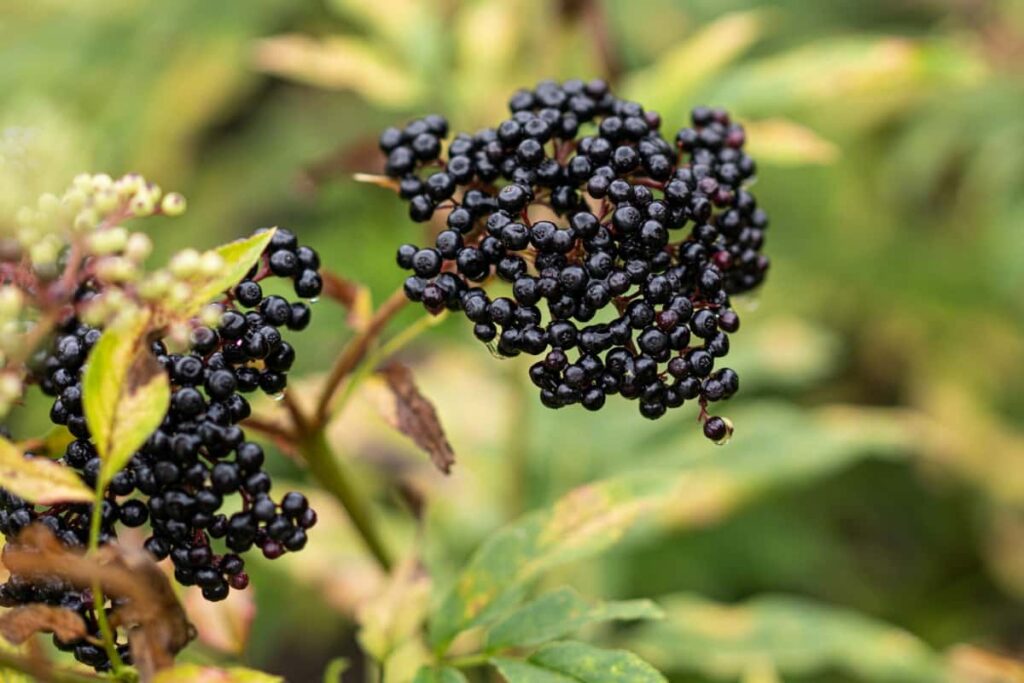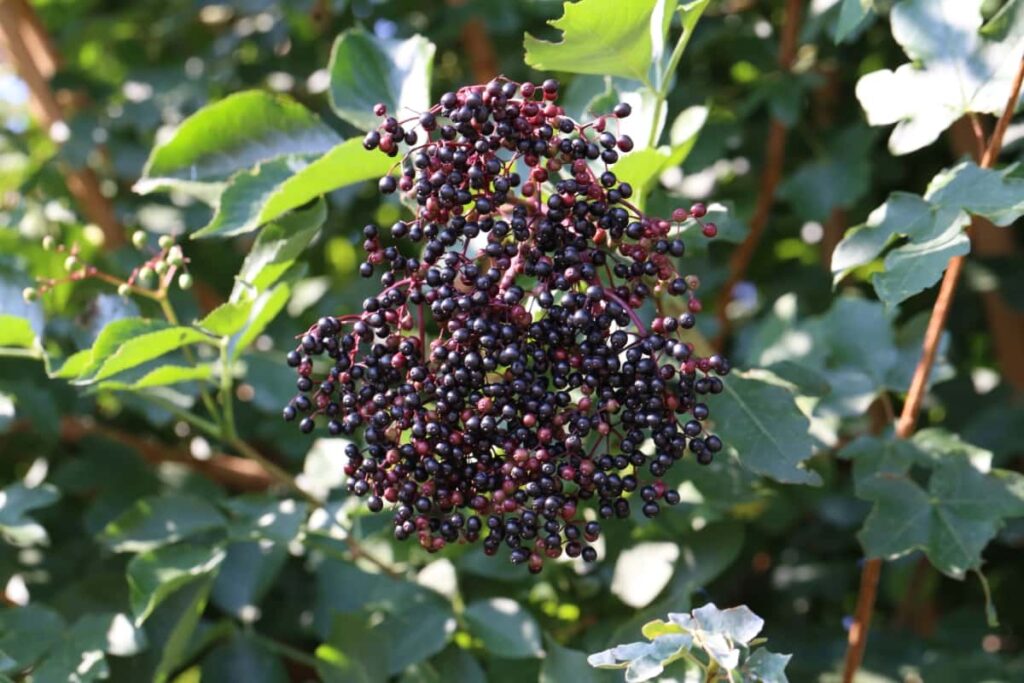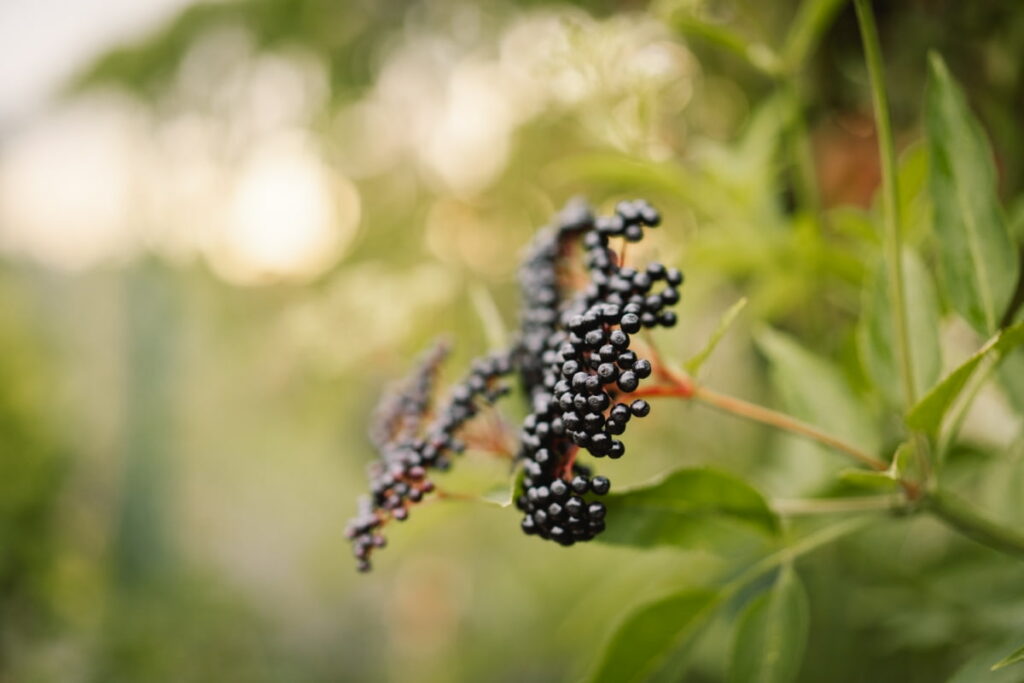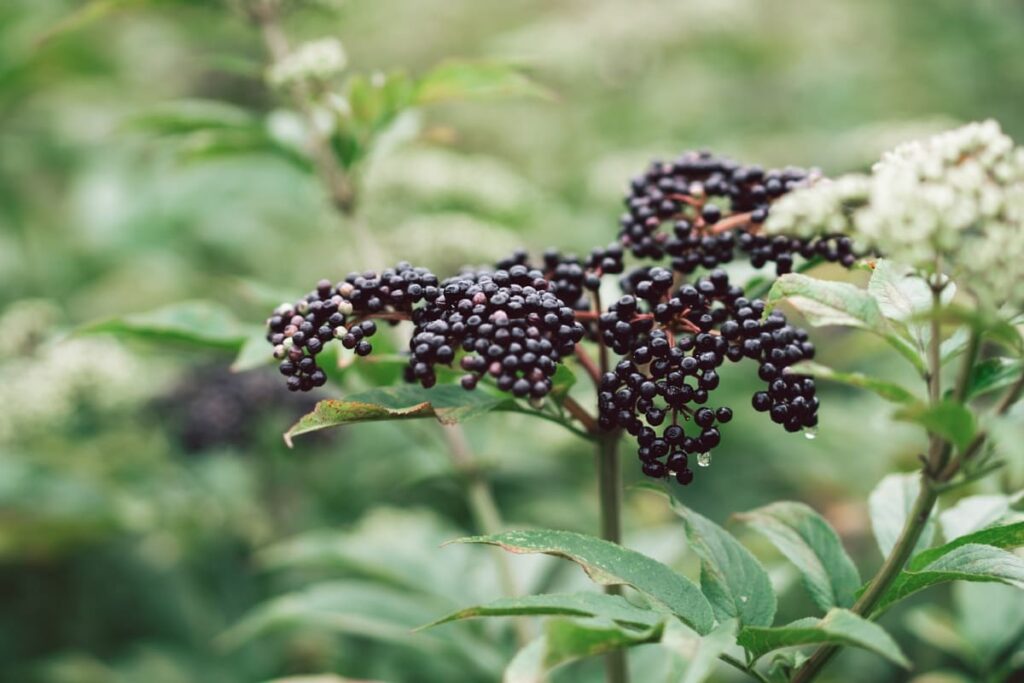Elderberries are small, purple-colored berries that grow on the elder tree. They have a rich, deep color and are about the size of a pea. Elderberries abundantly have antioxidants, vitamins, and minerals, making them a valuable choice for a healthy diet. They are versatile and can be used in various culinary and medicinal preparations.
Why Grow Elderberries? Elderberry Health Benefits and Uses
Growing elderberries provides a sustainable source of nutrient-rich fruit with numerous health benefits. Elderberries abundantly have antioxidants and vitamins that boost the immune system, promote heart health, and also reduce inflammation.

How to Grow Elderberry Bushes
Selecting the Right Elderberry Variety
Different Types of Elderberry Plants
- Common Elder: Traditional European variety with dark berries.
- American Elder: Native to North America, with smaller berries.
- Black Lace Elderberry: Ornamental variety with dark foliage.
- Adams Elderberry: Large clusters of berries suitable for culinary use.
- Nova Elderberry: Cold-hardy variety with high yields.
- York Elderberry: Large berries ideal for jams and wines.
- Johns Elderberry: Known for its large fruit clusters and disease resistance
Considerations for Choosing the Best Variety for Your Region
When selecting elderberry varieties, consider your region’s climate, soil type, and available space. Choose a variety that is suited to your USDA hardiness zone and has good disease resistance. Also, consider the intended use of the berries, whether for culinary purposes, medicinal extracts, or ornamental appeal.
Site Selection and Preparation
Choosing the Ideal Location for Your Elderberry Bushes
Select a sunny location for your elderberry bushes, preferably with at least 6-8 hours of sunlight per day. Ensure the site has well-draining soil to prevent waterlogging, as elderberries do not tolerate waterlogged conditions. Also, consider spacing requirements, as elderberries can grow quite large and may require ample room to spread.
Preparing the Soil for Planting
- Conduct a soil test to know its pH level and nutrient content. Elderberries prefer slightly acidic to neutral soil with a pH range of 5.5 to 7.0.
- If necessary, amend the soil to achieve the ideal pH level. Add organic matter such as vermicompost or well-rotted manure to improve soil structure and fertility.
- Clear the planting area free from weeds, rocks, and debris to provide a clean and healthy environment for the elderberry bushes.
Planting Elderberry Bushes
When and How to Plant Elderberries
- Select healthy elderberry plants from a reputable nursery or garden center.
- Dig holes for each elderberry bush, spacing them according to the variety’s requirements.
- If planting bare-root elderberries, soak the roots in water for a few hours before planting to rehydrate them. Spread the roots out in the hole and backfill with soil, ensuring the elderberry plant’s crown is at ground level.
- If planting potted elderberries, gently remove the elderberry plant from the pot, and the roots should be loosened if they are pot-bound. Place the plant in the center of the planting hole at the same depth it was growing in the container, and backfill with soil.
- After planting, water the elderberry bushes deeply to settle down the soil around the plant’s roots and provide moisture for initial growth.
Tips for Planting Bare-Root vs. Potted Elderberries
- Bare-root elderberries are typically less expensive and easier to transport, but they require more careful handling during planting to prevent root damage.
- Potted elderberries offer the convenience of already-established root systems and can be planted throughout the growing season, but they may be more expensive.
Caring for Your Elderberry Plants
Watering and Mulching Requirements
Water elderberry plants regularly, providing 1-2 inches of water per week, especially during dry periods. Apply a 2-4 inch layer of mulch with organic materials, like fallen leaves, straw, or wood chips, around the plant’s base to retain moisture, suppress weeds, and regulate soil temperature.
The Importance of Pruning and How to Do It Properly
Pruning elderberry plants is essential for maintaining vigor, improving air circulation, and increasing fruit production. In late winter or early spring, remove dead or damaged branches and thin out crowded growth. Cut back old canes to encourage new growth and maintain a healthy, productive elderberry bush.
In case you missed it: Strawberry Growing Information Guide

Fertilization and Soil Management
Choosing the Right Fertilizer for Elderberries
Select a balanced fertilizer with equal parts nitrogen, phosphorus, and potassium (NPK), such as a 10-10-10 or 15-15-15 blend. Alternatively, use organic fertilizers like compost or well-aged manure to nutrient enrich the soil without the risk of chemical buildup.
How to Maintain Soil Health for Optimal Plant Growth
Test the soil annually and adjust soil pH as needed to maintain pH 5.5-7.0. Add compost, aged manure, or organic mulch to the soil regularly to improve soil structure, fertility, and moisture retention. Apply fertilizers based on soil test recommendations and avoid excessive nitrogen, which can promote vegetative growth at the expense of fruit production.
Pest and Disease Control
Pests
- Aphids: These small, soft-bodied insects feed on elderberry leaves and stems, causing distortion and yellowing of foliage.
- Japanese Beetles: Adult beetles skeletonize leaves and feed on flowers and fruit, leading to significant damage.
- Spider Mites: These tiny pests suck sap from elderberry leaves, causing stippling and yellowing.
Diseases
- Powdery Mildew: This fungal disease appears as a white powdery growth on foliage, reducing photosynthesis and weakening plants.
- Leaf Spot: Fungal infections cause circular brown spots on elderberry leaves, leading to defoliation and reduced vigor.
- Phytophthora Root Rot: A soil-borne fungus that attacks elderberry roots, causing wilting, yellowing, and eventual plant death.
Organic and Chemical Control Methods
- Neem oil: Effective against aphids, Japanese beetles, and powdery mildew.
- Insecticidal soap: Soft-bodied insects such as aphids and spider mites can be killed on contact.
- Pyrethroid insecticides (e.g., permethrin): Effective against Japanese beetles, aphids, and other pests.
- Fungicides (e.g., sulfur-based or copper-based): Control powdery mildew and leaf spot diseases.
Harvesting and Pruning
When and How to Harvest Elderberries
Harvesting elderberries when they are fully ripe, usually in late summer to early fall. Berries will be dark purple-black and plump, with a slightly sweet aroma. Gently grasp the clusters of elderberries and clip them from the bush using sharp scissors or pruning shears. Be careful not to crush the berries.
Post-Harvest Pruning Techniques
Post-harvest pruning techniques involve removing dead, damaged, or diseased wood from elderberry bushes. Thin out the plant’s canopy to improve air circulation and light penetration, and perform renewal pruning every few years by cutting back one-third of the oldest canes to stimulate new growth.
Propagating Elderberries
Methods for Propagating Elderberries
Elderberry Propagation can be done through hardwood cuttings or seeds. Hardwood cuttings involve taking 8-10 inch sections of mature stems during dormancy, typically in late winter. Remove leaves and dip the cut end in rooting hormone before planting in well-drained soil. Seeds should be collected from ripe berries and stratified for several months before sowing in spring. Both methods require patience, but hardwood cuttings offer a quicker route to mature plants,
Tips for Successful Elderberry Propagation
- Choose healthy, disease-free parent plants for propagation.
- Take cuttings when the plant is dormant.
- Use rooting hormone to encourage root development.
- Keep cuttings consistently moist until roots develop.
- Monitor for signs of growth and transplant rooted cuttings into their permanent location once established.
In case you missed it: Vertical Strawberry Farming: A New Way to Increase Your Income and Yield

Elderberries in Culinary Uses
Elderberry Recipes
Elderberries offer a tart flavor and rich color. Enjoy elderberry syrup by simmering berries with water and honey; perfect for pancakes or cocktails. Make elderberry jam by cooking berries with sugar and lemon juice until thickened. Elderberry pie showcases the fruit’s sweetness in a flaky crust. Elderberry sorbet offers a refreshing dessert option.
In case you missed it: How to Start Blueberry Farming in India: Varieties, Yield, Cost, and Profit Per Acre

Conclusion
In conclusion, growing elderberries offers a rewarding experience for beginners, with their numerous health benefits, culinary versatility, and relatively easy cultivation. With proper Elderberry Plant Care, elderberry bushes thrive, providing a bountiful harvest of delicious fruit. Embrace the journey of elderberry cultivation, discovering the joys of nurturing these remarkable plants and reaping their flavorful rewards.
- Profitable Village Farming Business Ideas in 2024
- High-Yield Aquaculture: Fast-Growing Fish for Farming
- Effective Fish Pond Construction Techniques for Beginners
- Irrigation and Water Management in Pineapple Farming
- Blossom to Harvest: Mastering Flowering and Pollination in Papaya Farming
- Pig Fattening Essentials: From Selection to Sale for Beginners
- Raising Wagyu Cattle: A Complete Guide for Premium Beef Production
- Soil Types and Their Water Holding Capacity
- Optimizing Irrigation Schedules for Coconut Groves for Enhanced Yield
